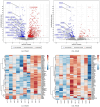Quantitative proteomics of dorsolateral prefrontal cortex reveals an early pattern of synaptic dysmaturation in children with idiopathic autism
- PMID: 38696595
- PMCID: PMC11484494
- DOI: 10.1093/cercor/bhae044
Quantitative proteomics of dorsolateral prefrontal cortex reveals an early pattern of synaptic dysmaturation in children with idiopathic autism
Abstract
Autism spectrum disorder (ASD) is a developmental disorder with a rising prevalence and unknown etiology presenting with deficits in cognition and abnormal behavior. We hypothesized that the investigation of the synaptic component of prefrontal cortex may provide proteomic signatures that may identify the biological underpinnings of cognitive deficits in childhood ASD. Subcellular fractions of synaptosomes from prefrontal cortices of age-, brain area-, and postmortem-interval-matched samples from children and adults with idiopathic ASD vs. controls were subjected to HPLC-tandem mass spectrometry. Analysis of data revealed the enrichment of ASD risk genes that participate in slow maturation of the postsynaptic density (PSD) structure and function during early brain development. Proteomic analysis revealed down regulation of PSD-related proteins including AMPA and NMDA receptors, GRM3, DLG4, olfactomedins, Shank1-3, Homer1, CaMK2α, NRXN1, NLGN2, Drebrin1, ARHGAP32, and Dock9 in children with autism (FDR-adjusted P < 0.05). In contrast, PSD-related alterations were less severe or unchanged in adult individuals with ASD. Network analyses revealed glutamate receptor abnormalities. Overall, the proteomic data support the concept that idiopathic autism is a synaptopathy involving PSD-related ASD risk genes. Interruption in evolutionarily conserved slow maturation of the PSD complex in prefrontal cortex may lead to the development of ASD in a susceptible individual.
Keywords: Brodmann area 9; autism; childhood; proteomics; synaptopathy.
© The Author(s) 2024. Published by Oxford University Press. All rights reserved. For permissions, please e-mail: journals.permissions@oup.com.
Figures

Similar articles
-
Increased number of excitatory synapsis and decreased number of inhibitory synapsis in the prefrontal cortex in autism.Cereb Cortex. 2024 May 2;34(13):121-128. doi: 10.1093/cercor/bhad268. Cereb Cortex. 2024. PMID: 38696601 Free PMC article.
-
Widespread alterations in the synaptic proteome of the adolescent cerebral cortex following prenatal immune activation in rats.Brain Behav Immun. 2016 Aug;56:289-309. doi: 10.1016/j.bbi.2016.04.002. Epub 2016 Apr 4. Brain Behav Immun. 2016. PMID: 27058163
-
Early Chronic Fluoxetine Treatment of Ts65Dn Mice Rescues Synaptic Vesicular Deficits and Prevents Aberrant Proteomic Alterations.Genes (Basel). 2024 Apr 3;15(4):452. doi: 10.3390/genes15040452. Genes (Basel). 2024. PMID: 38674386 Free PMC article.
-
Epigenetic underpinnings of the autistic mind: Histone modifications and prefrontal excitation/inhibition imbalance.Am J Med Genet B Neuropsychiatr Genet. 2024 Dec;195(8):e32986. doi: 10.1002/ajmg.b.32986. Epub 2024 Jun 4. Am J Med Genet B Neuropsychiatr Genet. 2024. PMID: 38837296 Review.
-
Modeling autism by SHANK gene mutations in mice.Neuron. 2013 Apr 10;78(1):8-27. doi: 10.1016/j.neuron.2013.03.016. Neuron. 2013. PMID: 23583105 Free PMC article. Review.
Cited by
-
A Refined Approach to Isolate Interneurons for High-Validity Epigenetic Studies in Human Brain Tissue.Methods Protoc. 2025 Jun 5;8(3):61. doi: 10.3390/mps8030061. Methods Protoc. 2025. PMID: 40559449 Free PMC article.
-
Impaired Aggrephagy, Interrupted Vesicular Trafficking, and Cellular Stress, Lead to Protein Aggregation, and Synaptic Dysfunction in Cerebellum of Children and Adults with Idiopathic Autism.Cerebellum. 2025 Aug 8;24(5):140. doi: 10.1007/s12311-025-01880-5. Cerebellum. 2025. PMID: 40779003 Free PMC article.
-
A most important gift: the critical role of postmortem brain tissue in autism science.Front Neurol. 2024 Dec 11;15:1486227. doi: 10.3389/fneur.2024.1486227. eCollection 2024. Front Neurol. 2024. PMID: 39726759 Free PMC article. No abstract available.
-
Heterogeneity and convergence across seven neuroimaging modalities: a review of the autism spectrum disorder literature.Front Psychiatry. 2024 Oct 16;15:1474003. doi: 10.3389/fpsyt.2024.1474003. eCollection 2024. Front Psychiatry. 2024. PMID: 39479591 Free PMC article. Review.
-
Prefrontal Blood Flow Activity During Drawing Intervention in School-Age Children with Autism: An fNIRS Hyperscanning Study.Brain Sci. 2025 Apr 24;15(5):438. doi: 10.3390/brainsci15050438. Brain Sci. 2025. PMID: 40426609 Free PMC article.
References
-
- Abraham JR, Szoko N, Natowicz MR. Proteomic investigations of autism spectrum disorder: past findings, current challenges, and future prospects. Adv Exp Med Biol. 2019:1118:235–252. - PubMed
-
- Akshoomoff N, Mattson SN, Grossfeld PD. Evidence for autism spectrum disorder in Jacobsen syndrome: identification of a candidate gene in distal 11q. Genet Med. 2015:17(2):143–148. - PubMed
-
- American Psychiatric Association . Diagnostic and statistical manual of mental disorders. 5th ed. Washington (DC): American Psychiatric Association; 2013
-
- Barembaum M, Moreno TA, LaBonne C, Sechrist J, Bronner-Fraser M. Noelin-1 is a secreted glycoprotein involved in generation of the neural crest. Nat Cell Biol. 2000:2(4):219–225. - PubMed
Publication types
MeSH terms
Substances
Grants and funding
LinkOut - more resources
Full Text Sources
Miscellaneous

